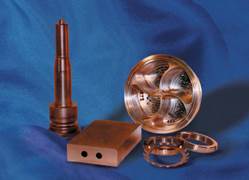Ion Beam Enhanced Deposition Process Provides Wear- and Corrosion-Resistant Coatings For Mold Surfaces
While there are a variety of mold coatings and coating processes on the market, a new technology is emerging that promises to help improve resistance to wear, corrosion and other surface-related phenomena on mold tooling surfaces.
While there are a variety of mold coatings and coating processes on the market, a new technology is emerging that promises to help improve resistance to wear, corrosion and other surface-related phenomena on mold tooling surfaces. The ion beam enhanced deposition (IBED) process, patented by Beamalloy Technologies, LLC (Plain City, OH)—a provider of innovative and highly engineered surface treatments applied to customer-supplied products—can be used to deposit metallic (Cr, Ni) as well as nitride hardcoats (TiN, Cr2N). The IBED process provides flexibility in the range of substrate materials that can be coated, and does not require post-coating refinishing.
Coating Specifics
According to Arnold H. Deutchman, Ph.D., Chairman and Director of R&D for Beamalloy, IBED processing combines the benefits of thermal diffusion processing and conventional coating technologies because the coating atoms first penetrate into the substrate to form a case layer in the surface, and then are grown out from this case layer as a thick coating.
IBED is a physical, non-equilibrium coating process implemented by the simultaneous bombardment of a growing film with an independently controllable beam of energetic atomic particles (see Figure 1). “The growing film is generated either by vacuum evaporation or ion beam sputtering,” Deutchman notes. “The independent beam of particles consists primarily of charged atoms (ions) extracted at high energy from a broad beam ion source. Because control of the ion beam is independent of the coating vapor flux, the energy of the ions in the beam can be varied over a wide range and chosen within a very narrow window. This allows a high degree of control over coating nanostructure and optimization of coating properties such as interfacial adhesion, density, grain size/morphology and internal stresses. Essentially a line of sight process, sources of the reactant fluxes are located so that they simultaneously illuminate the components to be coated. The components are mounted to an angling, rotating platen assembly that is used to uniformly expose all surfaces of the components to both reactant fluxes.”
Advantages
The following characteristics of the IBED process make it an ideal method for the coating of injection and extrusion mold tooling:
- Low Temperature: Since IBED is a physical—not a chemical or thermal process—coating adhesion and growth is achieved without the external application of heat and processing temperatures can be held below 200°F (93°C) if desired. Thus, there is no danger of dimensional distortion or tempering of precision mold tooling during coating.
- A Variety of Substrates Can Be Coated: Since IBED coatings are ballistically bonded to the substrate, there is no practical limit to the types of alloys that can be coated. A full range of mold steels and tool steels (P20, H13, S7, D2, A2, M4, and CPM10V) and stainless steels (316, 440C) can be coated. Alloys of non-ferrous materials, such as nickel, aluminum and copper also can be coated for use under certain conditions. This allows flexibility in mold tool material specification when trying to optimize both wear resistance and thermal conductivity.
- A Variety of Coatings Can Be Deposited: Metallic coatings including Cr and Ni and hardcoatings, including TiN and Cr2N, are routinely deposited on mold tooling using the IBED process at thicknesses in the range of 1 to 5 microns (40 to 200 μ-in.) (1 μmeter = 10-6 meter and 1 micron = 1 μmeter).
- No Regrinding or Repolishing Required: IBED coatings replicate the original surface on which they are deposited—regardless of whether the surface is highly polished or textured. Thus, there is no need for post-coating regrinding, repolishing or retexturing.
- Highly Repeatable Properties: Since the nanostructure of IBED coatings is highly uniform, the coatings are free of voids and pinholes, they exhibit improved adhesion and cohesion, and the mechanical properties of IBED-deposited coatings are better than the equivalent coatings deposited by plating or PVD. And the coating properties are highly repeatable—a must for volume production of precision mold tooling.
For improving the performance and productivity of your precision mold tooling, IBED technology is worth investigating.
Related Content
Questions and Considerations Before Sending Your Mold Out for Service
Communication is essential for proper polishing, hot runner manifold cleaning, mold repair, laser engraving and laser welding services.
Read MoreLaser Welding Versus Micro Welding
The latest battle in finely detailed restoration/repair of mold materials.
Read More5 Hot Runner Tips for Moldmakers and Molders
Best practices for initial hot runner tryouts and effective preventive maintenance.
Read MoreThink Safety: Eliminate Hazards Throughout the Shop
The tooling community is taking advantage of new products for safer mold shops and molding facilities.
Read MoreRead Next
Mold Preservation and Maintenance for Ultimate Productivity
Making a mold last with as little downtime as possible is the ultimate goal of a plastic molding manager. By taking some early, preventive steps, moldmakers can extend the life of the mold and save money in the long run.
Read MoreHow to Use Strategic Planning Tools, Data to Manage the Human Side of Business
Q&A with Marion Wells, MMT EAB member and founder of Human Asset Management.
Read MoreReasons to Use Fiber Lasers for Mold Cleaning
Fiber lasers offer a simplicity, speed, control and portability, minimizing mold cleaning risks.
Read More







.jpg;maxWidth=300;quality=90)











